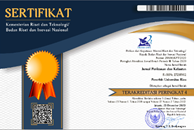The Effect of Different Light Intensity on Density and Carotenoid Content Dunaliella Salina
(1) Universitas Riau
(2) Universitas Riau
(3) Universitas Riau
(*) Corresponding Author
Abstract
Keywords
Full Text:
PDFReferences
Celekli, A. and Domenz, G. 2006. Effect Of pH, Light Intensity, Salt and Nitrogen Consentration on Growth and β-Karoten Acumulation by a New Isolate OfDualliella salina. World jurnal of microbiologi. 22, 183-189.
Facta, 2006. Pengaruh Pengaturan Intensitas Cahaya yang Berbeda Terhadap Kelimpahan Sel Dunnallella sp. dan Oksigen Terlarut dengan Simulator TRIAC dan Mikrokontroler AT89852. Jurnal Ilmu Kelautan Vol. 11 (2): 67-71.
Hasanuddin , M. 2012. Pengaruh Perbedaan Intensitas Cahaya Terhadap Pertuumbuhan dan Kadar Lipid Mikroalgae Scenedesmus sp. yang dibudidayakan pada Limbah Cair Tapioka. [Skripsi]. Fakultas Sains dan eknologi. UIN Malang.
Kawaroe, 2010. Mikroalga Potensi dan Pemanfaatannya untuk Produksi Bio Bahan Bakar. Bogor: IPB Press.
Kusdarwati, R., Mustofa, A., & Rahardja, B. S. 2011. Pengaruh penambahan vitamin B12 pada media blotong kering terhadap pertumbuhan populasi Dunaliella salina. Jurnal Ilmiah Perikanan dan Kelautan. 3 (1): 73-77.
Kusumaningrum, H. P., dan Zainuri, M. 2013. Aplikasi Pakan Alami Kaya Karotenoid untuk Post Larvae Penaeus monodon Fab. Jurnal Ilmu Kelautan. 18 (3), 143-149.
Pariawan, A. 2014. Pengaruh Cahaya Terhadap Kandungan Karotenoid Chorella sp. [Skripsi]. Surabaya: Universitas Airlangga.
Peri, P. L., G. M. Pastur and M. V. Lencinas. 2009. Light Intensities and Water Status of Two Main Nothofagus Species of Southern Patagonian Forest, Argentina. Journal of Forest Science, 55, 2009 (3). Santa Croz. Argentina. P.105, 107.
Pisal, D.S. dan S.S. Lele. 2005. Carotenoid Production from Microalga, Dunaliella salina. Indian Journal Biotechnol. 4:476-483.
Pradana, D. P. 2017. Pengaruh Intensitas Cahaya Terhadap Pertumbuhan Dan Kandungan Karotenoid Dunaliella sp. Pada Media Ekstrak Daun Lamtoro (Leucaena leucocephala). [skripsi]. Lampung. Universitas lampung.
Prihantini, N. B., B. Putri dan R. Yuniati. 2005. Pertumbuhan Chlorella spp. dalam Medium Ekstrak Tauge (MET) dengan Variasi pH Awal. Jurnal Makara Sains. Depok. 9 (1): 1-6.
Steinbrenner, J. and H. Linden. 2001. Regulation of Two Carotenoid Biosynthesis Genes Coding for Phytoene Synthase and Carotenoid Hydroxylase during Stress-Induced Astaxanthin Formation in the Green Alga Haematococcus pluvialis. Plant Physiol. American Society of Plant Biologists. America. Vol. 125. pp. 811-815.
Sudjana, Nana. 1991. Tuntunan Penyusunan Karya Ilmiah. Bandung : Sinar Baru.
Sugiati N. 2016. Peningkatan Kandungan -Karoten Dunaliella salina Akibat Pemberian Intensitas Cahaya yanng Berbeda. [Skripsi]. Surabaya : Universitas Airlangga.
Sukarman dan Hirnawati, R. 2014. Alternatif Krotenoid Sintesis (Astaxantin) untuk Meningkatkan Kualitas Warna Ikan Koki (Carassius auratus). Jurnal Widyarise Vol 17 : 334-342.
Tafreshi AH, Shariati. 2009. Dunaliella biotechnology: Methods an Applications. Journal of Applied Microbiology. 107(1): 14-35.
Wahyuni, N. 2018. Pengaruh Ekstrak Daun Kelor (Moringa oleifera) Pada Media Kultur Terhadap Pertumbuhan dan Kandungan KarotenoidDunaliella salina.[Skripsi]. Banyuwangi: Universitas Airlangga.
Zainuri, M., H.P. Kusumaningrum and E. Kusdiyantini. 2006. Microbiological and Ecophysiological Characterisation of Green Algae Dunaliella sp. for Improvement of Carotenoid Production. J. Natur Indonesia. 10
Article Metrics
Abstract view : 593 timesPDF - 1275 times
DOI: http://dx.doi.org/10.31258/jpk.25.1.36-43
Copyright (c) 2020 Jurnal Perikanan dan Kelautan
Gedung Marine Center Lt 2. Fakultas Perikanan dan Kelautan Universitas Riau



